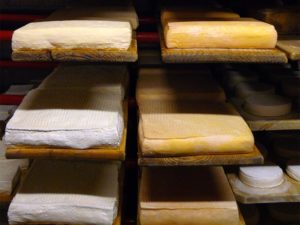Editor’s Note: This sponsored column is written by Katie Carter, cheesemonger at Arrowine (4508 Lee Highway)
 Cheese has been around for thousands of years not only because it provides us with so much nutrition but because it tastes so damn good. Like wine and beer, it offers a huge variety of aromas, flavors, and textures. And like wine and beer, there is a “proper” way of tasting cheese. But you don’t need to be a cheesemonger, or even a connoisseur, to taste like a pro. Here is a simple guide to fully enjoying your next bite of real cheese.
Cheese has been around for thousands of years not only because it provides us with so much nutrition but because it tastes so damn good. Like wine and beer, it offers a huge variety of aromas, flavors, and textures. And like wine and beer, there is a “proper” way of tasting cheese. But you don’t need to be a cheesemonger, or even a connoisseur, to taste like a pro. Here is a simple guide to fully enjoying your next bite of real cheese.
Step 1. Look.
You can learn a lot from a cheese just by its appearance. If there is one, look at the rind. Is it moldy? Wrinkly? Does it have a pattern? What color is the rind? Is the paste (interior) firm, runny, or pudgy? Again, what color is the paste? If it is naturally bright yellow, it’s most likely made from cow’s milk. A pure white paste tells you it is made from goat’s milk. Are there holes? Some holes in cheese are formed by gas, most are so-called “mechanical holes” that are just spaces between the curds. That tells you the curds were only pressed by gravity and not by external weight.
Most people don’t do this but go ahead, don’t be shy. Get your nostrils right up into it. Try not to mask the aromas with strong hand soap, perfume, etc. You can be broad or very specific in your observations. Is the aroma strong or mild? Would you describe it as earthy, fruity, nutty, or herbaceous? Try to dig deeper and identify that earthy quality. Does it smell mushroomy, like wet leaves, or like a Jersey cow barn? These are simply examples; trust your nose. Also, the aromas of a cheese may not correlate with the actual flavor. In other words, if a cheese aroma is quite strong, the flavors may not be. For example, Epoisses de Bourgogne has a pretty intense aroma (so strong it was banned from the Parisian metro) but its flavor is not overpowering.
Step 3. Taste.
And don’t rush it. Inhaling through your nose while chewing allows you pick up finer details. Keep in mind, there is an evolution of flavor. What you taste up front might change and finish with a completely new flavor. Again, be as broad or specific as you want. Does it taste nutty or taste like roasted hazelnuts? Fruity or peachy? Meaty or like roasted lamb? There are hundreds of flavors descriptors (e.g. grassy, caramel, metallic, vegetal) and even more words to modify those descriptors (e.g. strong, delicate, biting).
Always enjoy cheese at about room temperature. Cold temperatures conceal aromas and flavors, while altering textures. Take the cheese out of your refrigerator at least 30 minutes before you enjoy. Also, if you have bought a pre-cut piece of cheese, the plastic wrap may mask the flavor. Unwrap it and scrape a touch off of the surface where it touched the plastic. This is called “facing” the cheese. Cheesemongers will do this before giving samples at the cheese counter. If you really want to learn more, start taking notes. Record everything from colors to mouthfeel. Formaticum makes a nice journal.
Remember to convey your observations and preferences when at the cheese counter, it will really help your cheesemonger find you the perfect cheese. Have fun and let me know if you have any questions in the comments section.
Katie Carter is Arlington’s first and only ACS Certified Cheese Professional. She has worked in the cheese industry for ten years as a cheesemaker, cheesemonger, and educator. She can be found on Twitter@AfinaCheese. The views and opinions expressed in the column are those of the author and do not necessarily reflect the views of ARLnow.com.
Community discussion guidelines: Our sponsored columns are written by members of the local business community. While we encourage a robust and open discussion, we ask that all reviews of the businesses — good or bad — be directed to another venue, like Yelp. The comments section is intended for a conversation about the topic of the article.



